|
|
Post by Lee Martin on Dec 7, 2014 19:45:51 GMT -5
Another very informative photo essay from David.....and one I've been fortunate enough to be a small part of. ____________________________________________________________________ 100 yards offhand, FA M83 .45 Colt 4-3/4", Leupold 4x28mm LER. Last five shots of the day. Cast 335 LFN GC deep seated over 20/H110=1115 fps. First three shots with Freedom Arms laminated rosewood; last two shots with Pachmayr grip. Same point of aim (POA), with same point of impact (POI).  Cast .45 335 LFN GC seated deep over 20/H110 in M83. 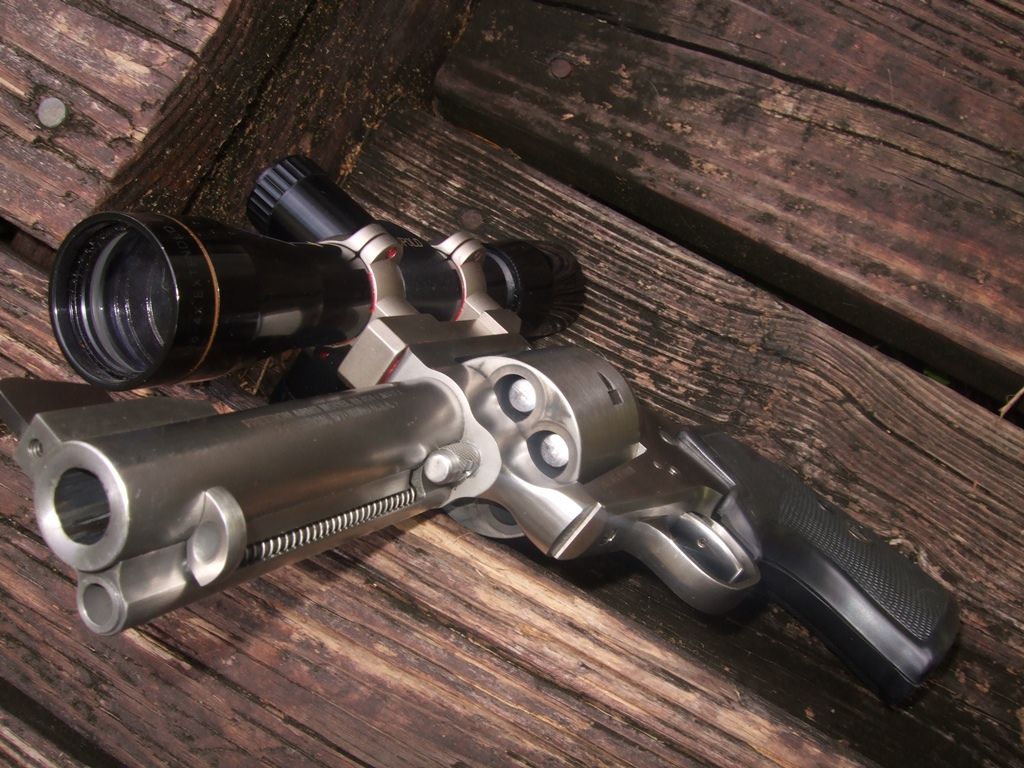 Deep seating increases neck tension to promote uniform ignition of otherwise light (19-20 grains) charge of 296/H110, fro 1,100 fps, with accuracy between 2 and 4-inches @ 100 yds. HS-6 does nearly as well @ 1,000-1,050 fps. 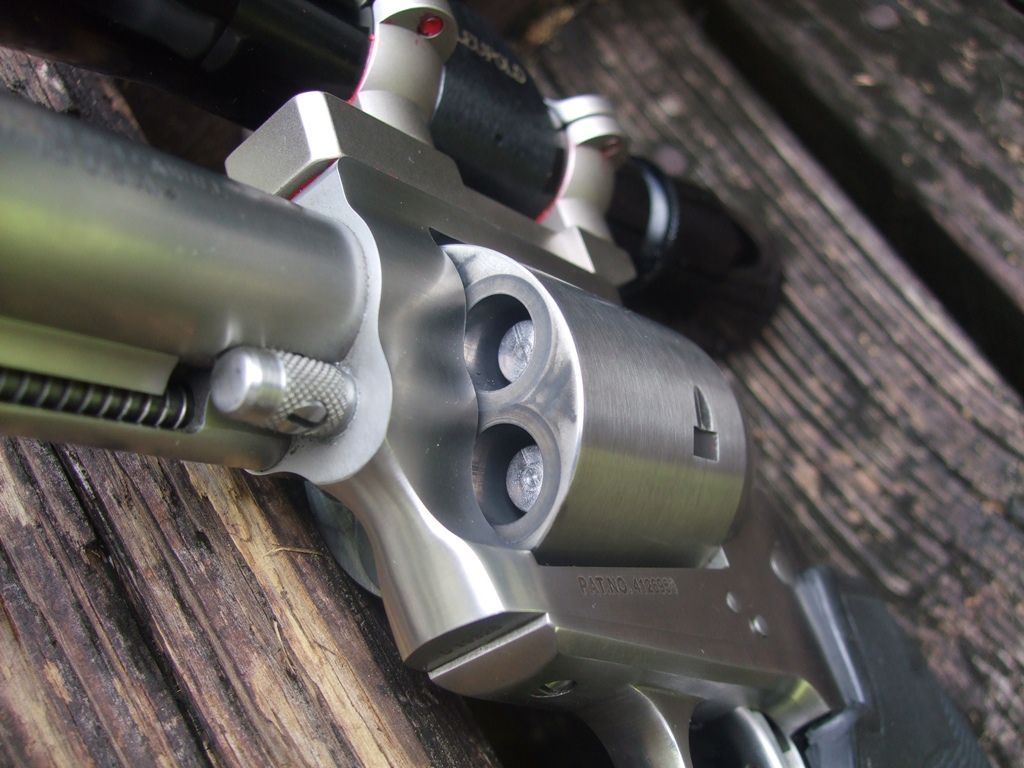 Cast .452" 335 LFN Gas Check with brass .510" 420 LFN. Brass bulletr fired into caliche pulverized limestone @ 1,200 fps from John Linebaugh built Ruger in .500 Linebaugh. 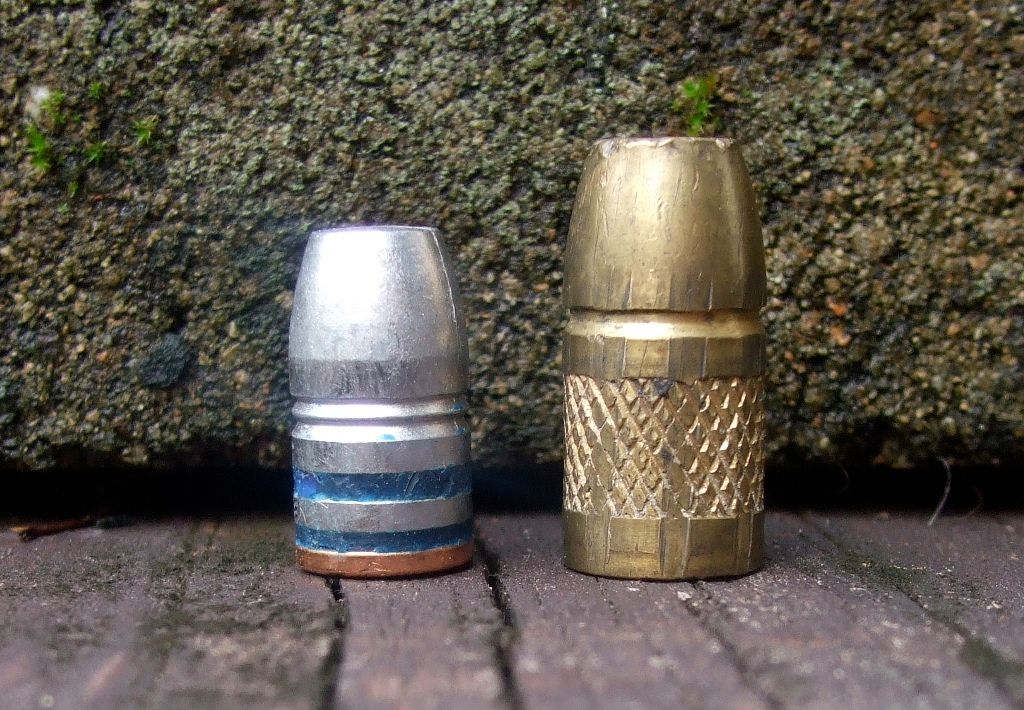 Cast .452" 300 WFN Plain Base. Lousy accuracy. Sent to Lee Martin (with drawing) for hollow pointing on lathe, experiment to move longitudinal balance rearward, hopefully improve accuracy. 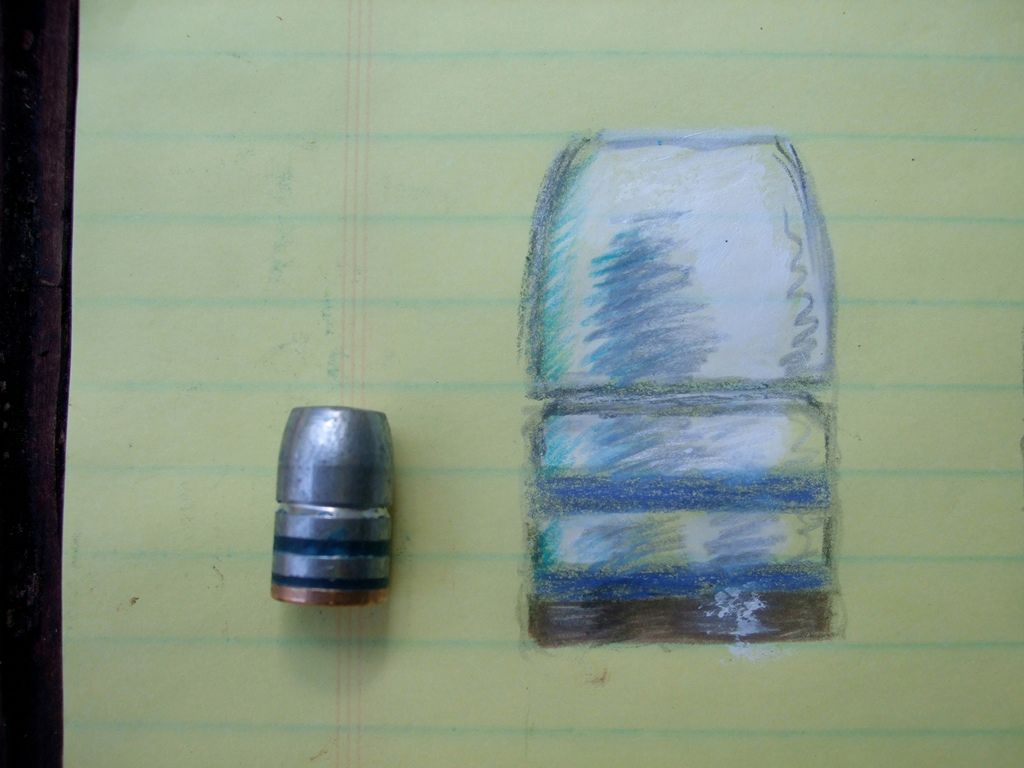 Cast .452": 300 WFN GC and 365 LFN PB. Drawing suggests hollow point possibilities. Lee found 300 WFN out of balance. David's best group with 300 WFN at 100 yds about 12", with 3 to 4-foot groups more likely from M83 .45 Colt 4-3/4" with Leupold scope.  Lee lathed hollow point reduces .45 WFN GC from 300 to 276 grains. Only things killed so far, gallon water jugs, little chips of hard lead breaking off. 276 WF HP deep seated over 13.5/HS-6 in Starline .45 Colt brass, WLP primer. COL=1.450-1.457". 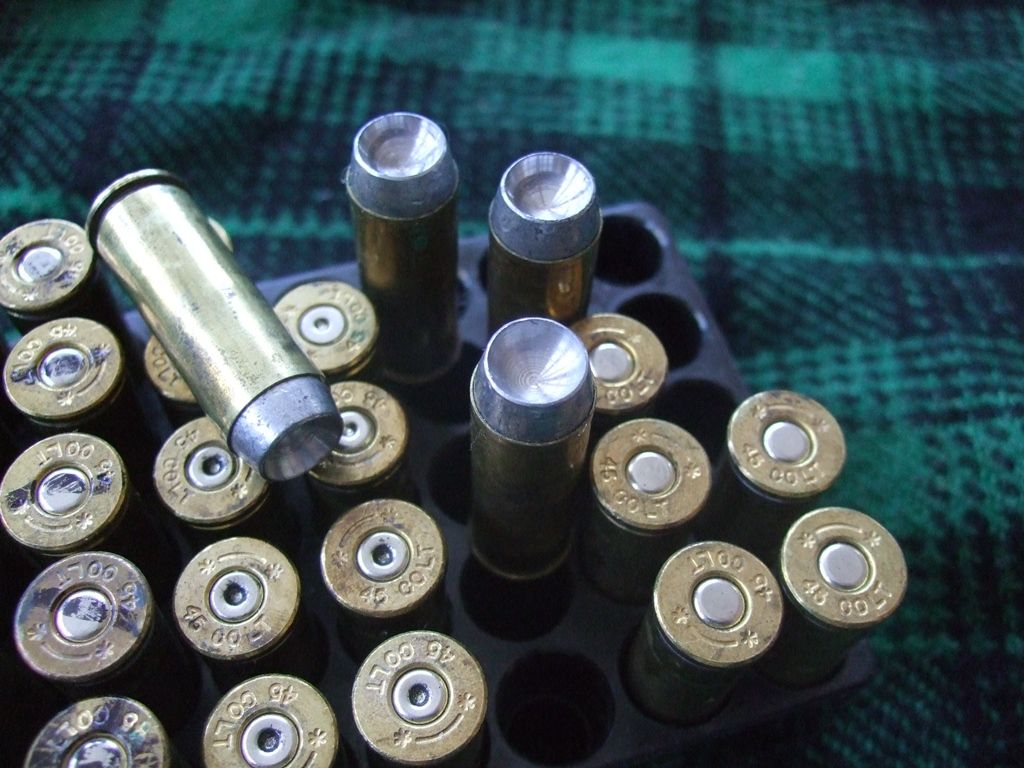 Ruger 03 .45 Colt with 300 WFN GC, now turned 276 grain Wide Hollow Point GC 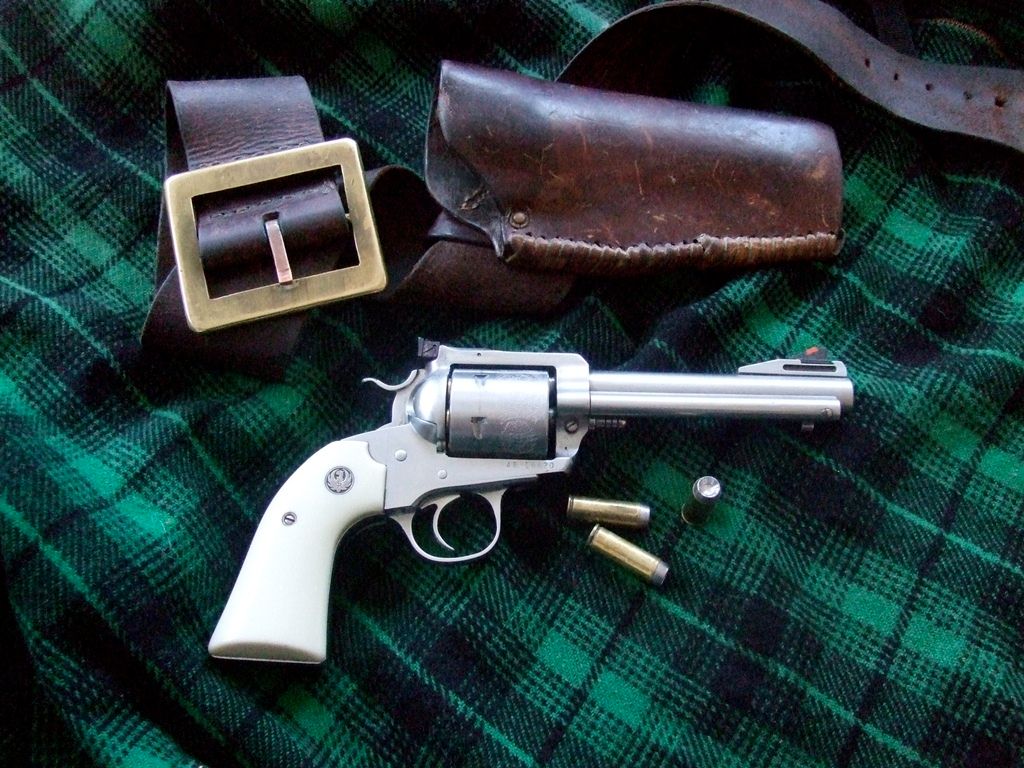 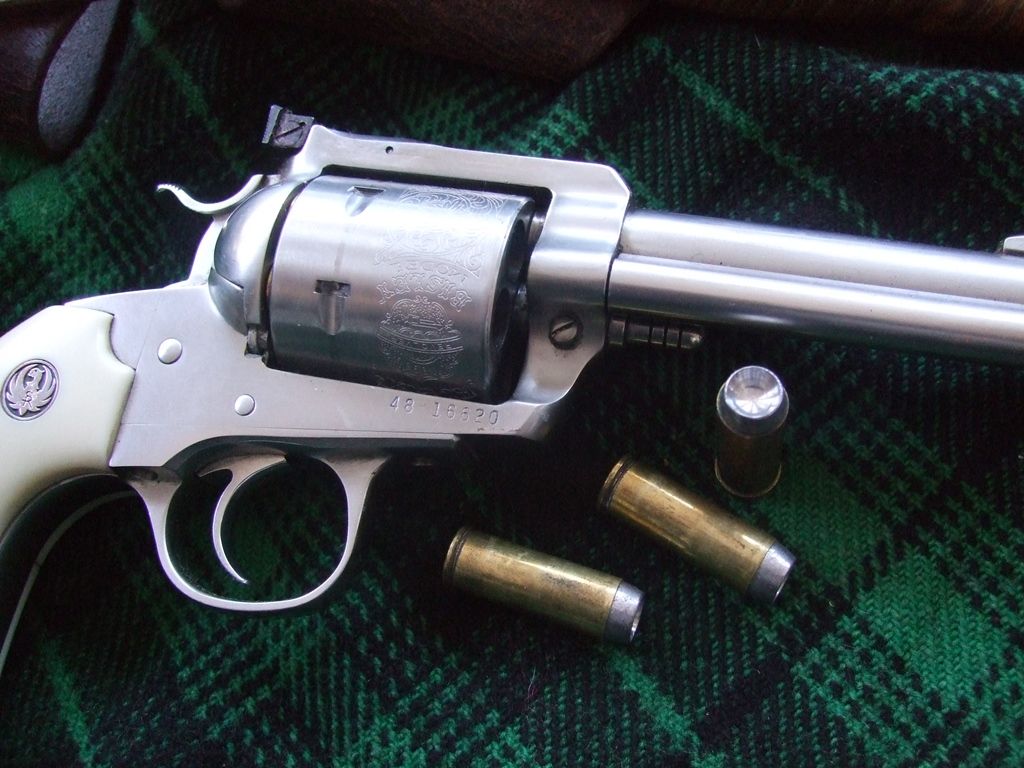 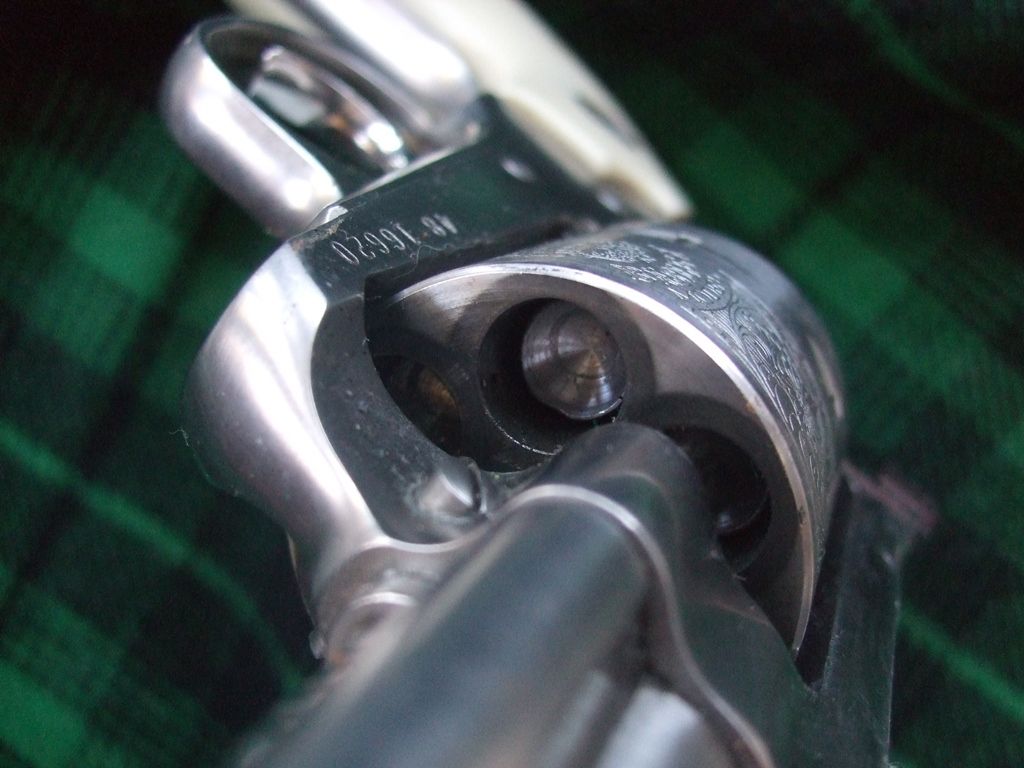 Cast .452" Volcanic 276 grain HP Gas Check (HP drilled into 300 WFN GC), Deep seated over 13.5/HS-6 in Starline .45 Colt brass with WLP. COL=1.450-1.457". First shot hit POA (Point of Aim) @ 25 yds. Second shot hit 2.2" above POA @ 75 yds. Fired with deerskin gloves, from rest. Temperature 15 degrees fahrenheit. 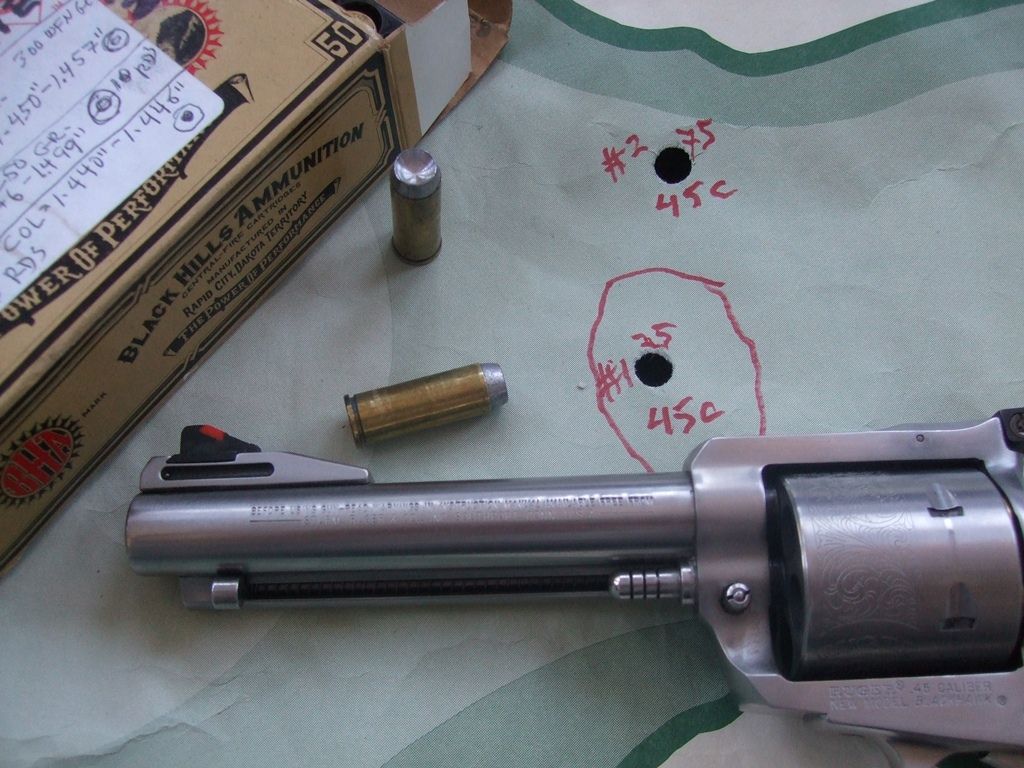 100 yards, Ruger 03 .45 Colt. 3x3 shors=1.9-inches. Cast Volcanic 276 grain HP GC, deep seated over 13.5/HS-6, for COL=1.450-1.457". Point of Impact 2" below Point of Aim @ 100 yds. Rather astounding accuracy, considering bullet began as cast 300 WFN GC, which recored a very best group of 12-inches @ 100 yds, but which generally failed to keep all shots on 4'x5' cardboard at 100 yds. David sent batch of 300 WFN GC to Lee for volcanic hollow pointing, with expectation bullet could only be improved by removing weight from nose----without shortening length. Another surprise: very modest trajectory at 100 yds. With mercury at 15 degrees, and having spent previous hour sorting out muzzle loading rifles, fingers were numb. Nevertheless, a frozen finger must squeeze----not jerk----trigger. 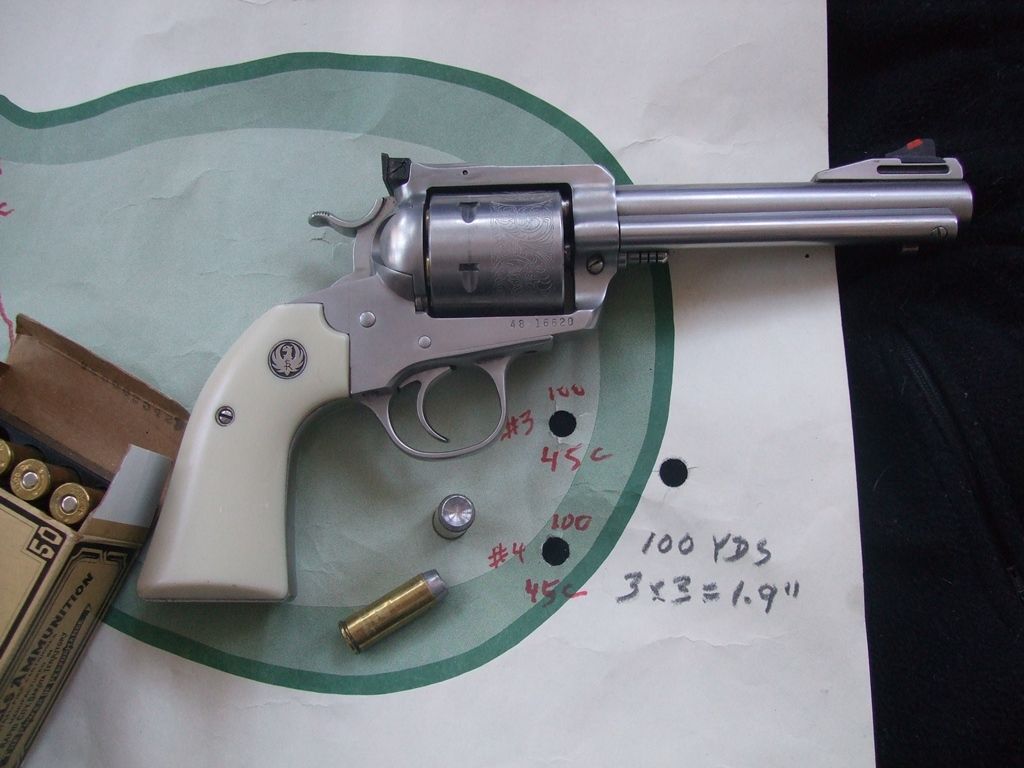 -Lee www.singleactions.com"Building carpal tunnel one round at a time" |
|
|
|
Post by Lee Martin on Dec 7, 2014 20:15:03 GMT -5
When David asked me to nose his WFNs, it seemed like a long-shot. Reported accuracy at 100 yards was dismal, and with his ability and a FA 83 I knew it had to be the bullet. Hollow-pointing them was last-ditch and at best I hoped we'd get them on paper. But it didn't cost anything to try, so he mailed them north. Along with the bullets, he also provided a 7 page letter explaining the proposed fix. That document included the drawings you see above. One of his sketches paralleled a hollow-point my dad and I devised in 1993. At that time, we had just begun shooting Speer's 110 gr spire point in our .30 Streaker Rugers. The bullet worked, but to clear the cylinder we were seating farther into the ogive than I liked. This was remedied by lathing the nose and drilling the tip, which dropped it back to 85 grains. Our first bit was aggressive and hogged more of the meplat than we intended. We tried them anyway and what a surprise. The bullet, as odd as it looked, shot on a line out to 100 yards. In fact, we could stay on a 10" rock with open sights all day (off-hand!!!). We chalked it up to dumb luck and never nosed one like that again (aside from those used in the Streaker). Close-ups of the hacked Speer: 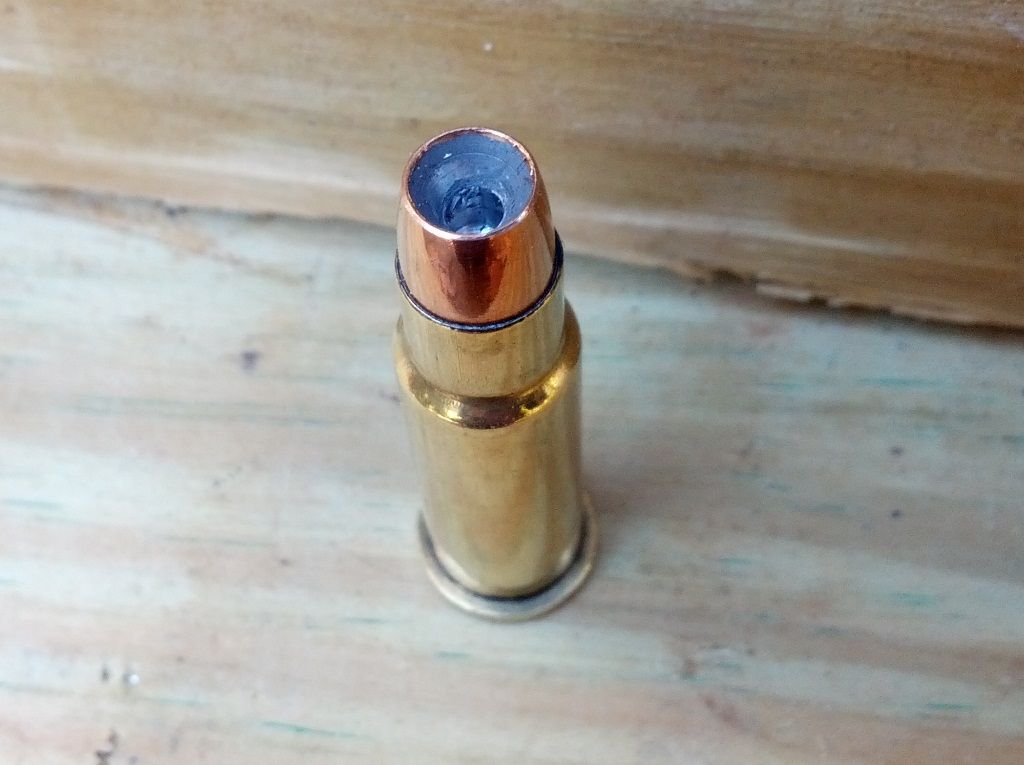   Fast forward 21 years to the Bradshaw-Martin "volcanic", as David calls them. His 100 yard target with the 276 grain shows some promise and has us wondering. I've decided to "volcano" more flat-noses for us to assess. And after his description of what they did to a milk jug, he may try them on game (assuming they yield the sort of accuracy we expect). I'll play with the design in some of my guns, and certainly send more David's way. Stay tuned. BTW, I posted these shots in a previous thread, but felt they'd attach well to the photo essay: Lathing the nose: 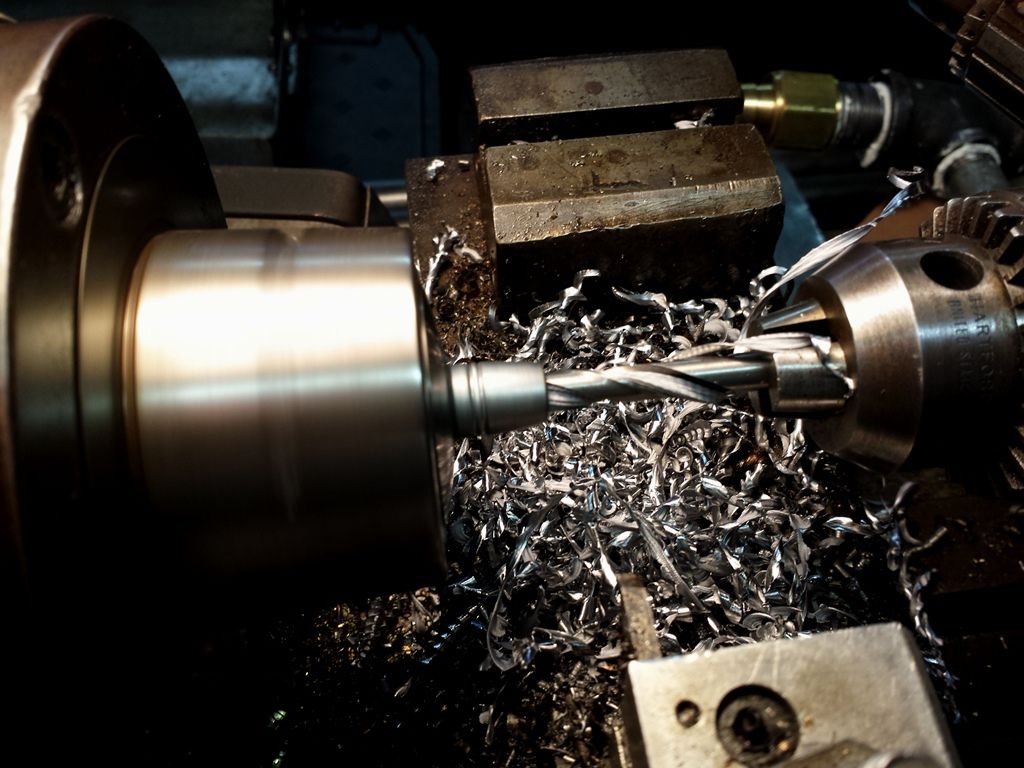 Checking the hollow-point on a depth gauge: 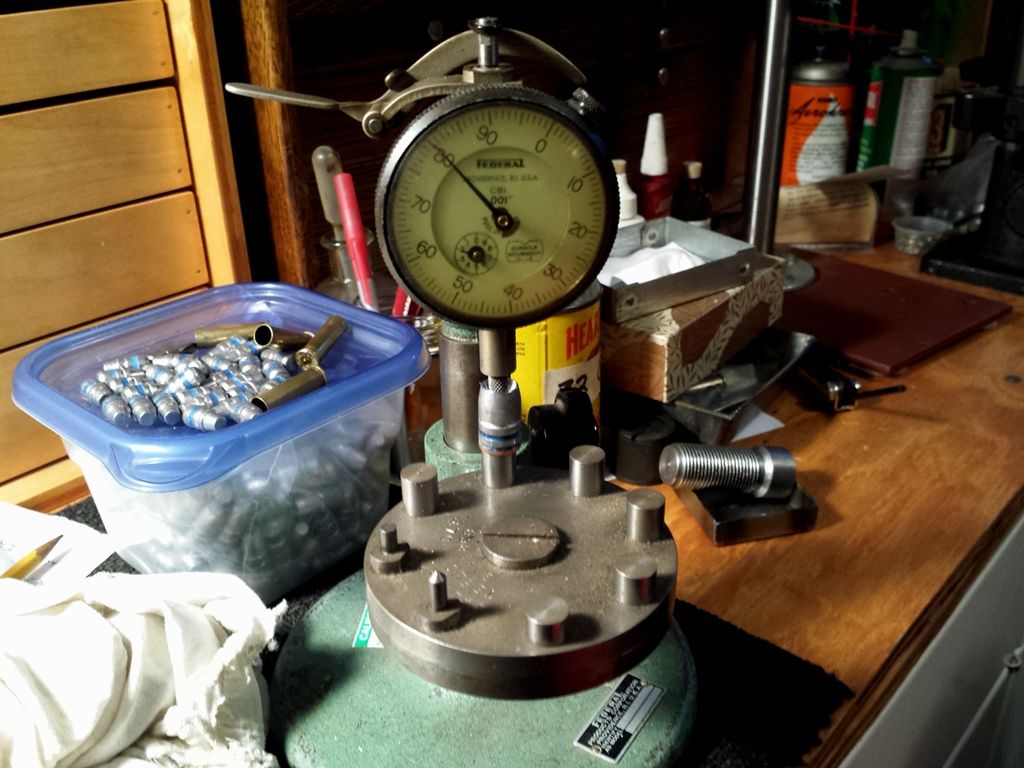 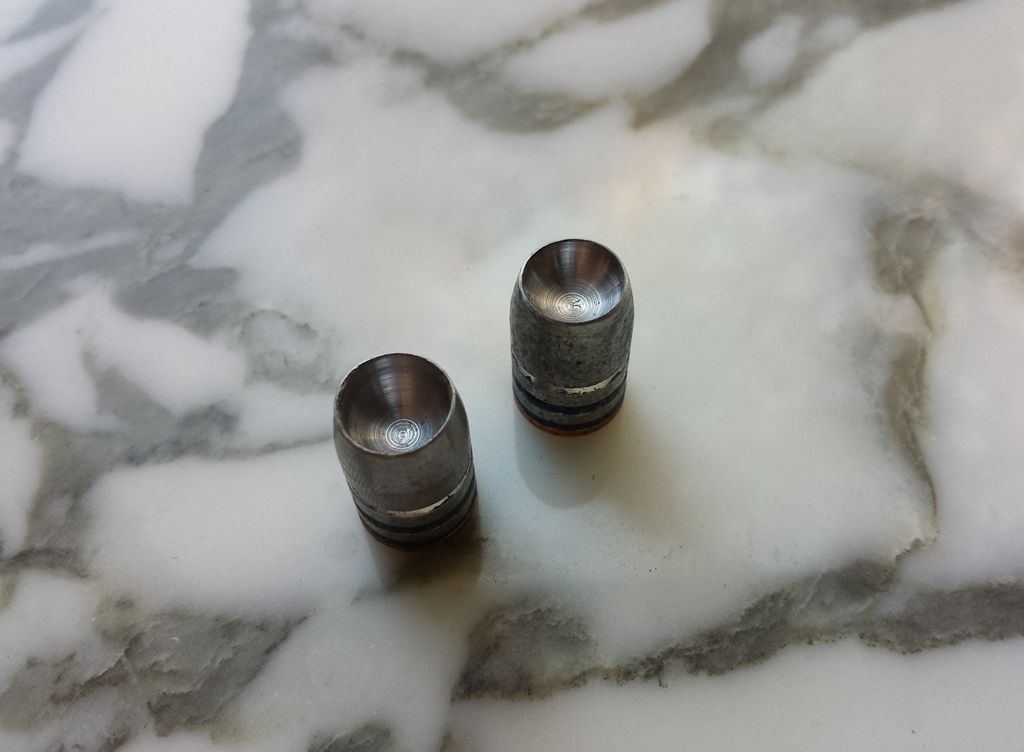 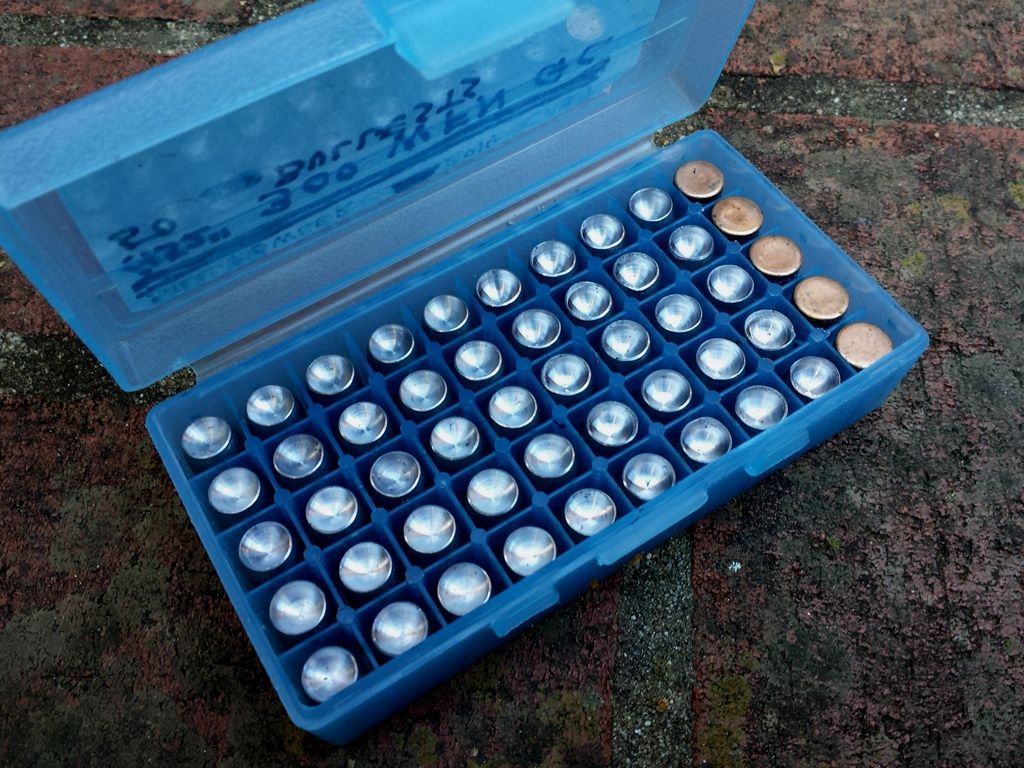 -Lee www.singleactions.com"Building carpal tunnel one round at a time" |
|
|
|
Post by paul105 on Dec 7, 2014 21:35:03 GMT -5
My son played minor league baseball for several years. The camp followers (young women looking for the big score or "the association" were always present). Point being, I don't want to appear to be "one of those". With that said I just love these photo essay threads and can't believe how lucky we are to benefit from David (and of course Lee's) expertise. I hope these continue in perpetuity.
Now for the question -- first photo -- actual or implied difference in accuracy potential with Pachys vs. Rosewood -- additional discussion would be welcomed.
Thanks,
Paul
|
|
Fowler
.401 Bobcat
  
Posts: 3,667
|
Post by Fowler on Dec 7, 2014 23:01:23 GMT -5
David what are you actually aiming at? From the looks of many of these pics it would seem the center of a cardboard sheet, it would seem shooting sml groups without a good target you can see would be very tough.
Also I amazed that a small hollowpoint cavity would have such a definitive impact on the bullet and the group sizes it will hold.
|
|
|
|
Post by Markbo on Dec 7, 2014 23:38:37 GMT -5
What about drilling a smaller HP in that bullet? The edges just look awful fragile. I was thinking about .300 - .340" hole instead of .430"+
|
|
cmillard
.375 Atomic
   MOLON LABE
MOLON LABE
Posts: 1,996
|
Post by cmillard on Dec 8, 2014 9:39:10 GMT -5
lee or Bradshaw--what alloy are you using in those bullets? very fine shooting and very interesting. are those punch bullets that you used to shoot the limestone--those things must penetrate like crazy! barely any damage to the bullet
|
|
|
|
Post by bradshaw on Dec 8, 2014 18:31:55 GMT -5
[/b]Photo #5 clarification: bullet is cast .452" 300 grain Wide Flat Nose Gas Check[----not plain base; the error is mine. Bullet at about 18 brinnell, from LBT mold. For whatever reason, a small, yet disconcerting, dome or convexity to the meplat. I tried to make 'em shoot, but it was ugly. Jumped from 25 yard sight-in to let's-get-down-to-business 100 yards groups. GROUPS? Sufferin' baglapper, I couldn't get all on refrigerator cardboard!
We have Lee Martin's exacting nature and machine tool talent to thank for facilitating this experiment in ballistic salvation.
From a highly suspect slug to a true bullet with one pass of a ball cutter, and really seeing it start to come alive in the Ruger 03, that is a treat. We seeing accuracy which we must now substantiate. Providing we back up this Cinderella bullet with consistent performance, we may ad vance the accuracy picture of revolver bullets.
Shall try to answer questions members raise, along with our own.
David Bradshaw
Note: tried to undo bold in above text.
-David
|
|
|
|
Post by bradshaw on Dec 8, 2014 18:47:52 GMT -5
paul105.... one 5-shot offhand group at 100 yards, three shots with factory wood grips, two with Pachmayr rubber. Strictly to see whether bullets would impact same area. They did. There is one wide shot with the rosewood grips. Interestingly, four of five shots land in 5-inches. While I seem to shoot both grips fairly well, preference is Pachmayr for rocks & dynamite. (335 LFN GC deep seated over 20/H110 is not rocks & dynamite.)
Each shooter must discern through shooting his and her best grip, hand position and squeeze.
David Bradshaw
|
|
|
|
Post by bradshaw on Dec 8, 2014 19:00:00 GMT -5
Marko.... your question----why not drill smaller hollow point? Answer, why?
Pathetic "accuracy" of of 300 WFN GC indicated radical surgery the valid gamble. I could not have done it with a drill, although it may have made a bullet perfectly good across a card table. Beside longitudinal balance, I harbor a suspicion the Volcano may induce an aerodynamic centering. Same accuracy from a smaller hollow point of same weight would disprove suspicion.
David Bradshaw
|
|
|
|
Post by bradshaw on Dec 8, 2014 19:03:31 GMT -5
cmillard.... the brass .50 caliber 420 grain Punch Bullet at 1,200 fps penetrated two to three inches of Texas rubble limestone, a.k.a. caliche. No lead bullet would have survived that ordeal ready to be loaded and fired again.
David Bradshaw
|
|
|
|
Post by bradshaw on Dec 8, 2014 21:14:52 GMT -5
Bill.... Point of Aim on the horizontal man silhouette was:
* shot #1: 25 yds----center neck.
* shot #2: 75 yds----center neck.
* shots #3, 4, 5: 100 yds----center skull.
In first photo of Vol. XLVII, POA was center of cardboard square. A large target often sharpens sight picture, as eye is not distracted by a tiny aiming point. Main thing is to retain, remember, and repeat a sight picture, even as the light changes, similar to musician playing same note over & over.
When sighting on game, brain nails a small spot where bullet must go.
David Bradshaw
|
|
|
|
Post by bradshaw on Dec 9, 2014 10:50:52 GMT -5
Fowler questioned validity of comparing 300 grain WFN GC shot through M83----terribly inaccurate----with same bullet 'volcano'd" to 276 grains, then shooting modified bullet in a different revolver, specifically the Ruger 03. As I haven't the M83 with me, there is no way to try it at 100 yds with the 276 Volcano (i.e., modified 300 WFN GC).
Shot a few water jugs with 276 Volcano in M83 before heading north. Did not save unaltered 300 WFN GC to try in Ruger 03. Hideous performance of the 300 WFN in M83 condemns consideration for Ruger 03. The bullet is out of balance; whether imbalance issue involves Center of Gravity or Longitudinal Balance----or both----this 300 WFN GS has a disease which shooting from a different revolver won't cure.
Initial shooting of the 276 Volcano validates our experiment to salvage from a horribly inaccurate slug a useful bullet. Experiment far from complete.
DavidBradshaw
|
|
|
|
Post by bradshaw on Dec 11, 2014 10:55:35 GMT -5
A few details on the Ruger 03:
* .45 Colt and .45ACP have .451" chamber throats.
* chamber-to-bore offset (chamber alignment) tightly averages around .005"-inch.
* barrel groove diameter .451", with .452" X .800" freebore.
* short, smooth 11-degree forcing cone.
David Bradshaw
|
|
cmillard
.375 Atomic
   MOLON LABE
MOLON LABE
Posts: 1,996
|
Post by cmillard on Dec 11, 2014 11:30:07 GMT -5
bradshaw, do ALL of the throats measure .451? would opening them up solve any problems?
|
|
|
|
Post by bradshaw on Dec 11, 2014 13:05:33 GMT -5
cmillard.... much of my education on what makes a revolver shoot has been learned on the firing line. Revolver accuracy is a relative term, and to give it meaning it is important to be specific about distance and group size. At 100 yards, an "accurate" revolver should group five shots in 4-inches. Some silhouetters may accuse my figure as too generous but, permit me to continue. There is a huge difference between a 4" group and a 2" group. We are talking accuracy intrinsic to the revolver.
Simple and brutally reliable as a good revolver is, it remains dangerous to flood discussion with declarative statement. There are mysteries to a bullet jumping from a chamber separate from the barrel----slamming through forcing cone into rifing, then departing the muzzle, to be joined by bullets from other chambers to form a palm-size group a football field downrange. Dimensional relationships are many; some combinations work, others do not. The reason I am such a critic of a poor forcing cone is because the forcing cone stands as a make-or-break component of accuracy. A rotten forcing cone kills the accuracy of a fine chamber and barrel----all by itself. When you look for forgiveness in a revolver, don't look for it in a poor forcing cone.
Chamber exits are another dimensional mystery.
The Ruger 03 has all .451" throats (a.k.a. exits, or exit holes). It should not shoot cast .452" bullets. But it does. To your question, the shoulder of a .452" bullet will not enter the throat; they must be deep seated, enough so that the round chambers and the cylinder spins freely. So far,. the Volcano bullets have leaded neither throats nor bore. On the other hand, soft cast or swaged .452" do start to lead ahead of the freebore in the barrel. Accuracy with these projectiles is superior to numerous other revolvers, yet good enough for head or shoulder shots on a rabbit from half a football field, or clipping the head off a partridge at forty. When I mentioned to Lee Martin a feint inclination to open the throats to .452", he said, "I wouldn't do it, David."
Chamber exit diameter may not be as critical to accuracy as some shooters claim. This statement is far from absolute, as a slightly tight or a loose throat in conjunction with a bad forcing cone can be counted on to distort the bullet. And the balance characteristics of the bullet itself factor each time a dimensional detail is off.
The best assurance a revolver will shoot straight comes with a tight specification package, with dimensions accumulating in the right direction.
David Bradshaw
|
|


































